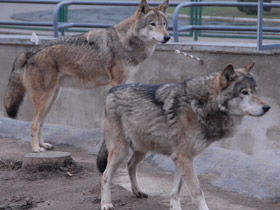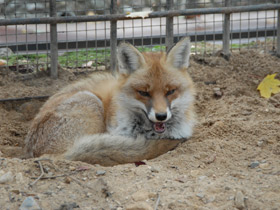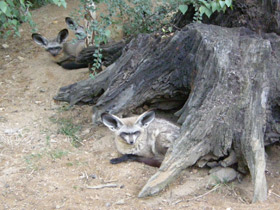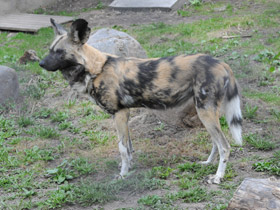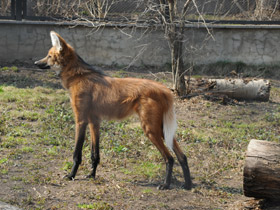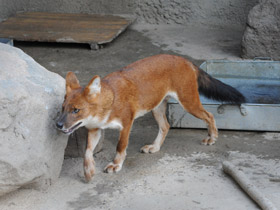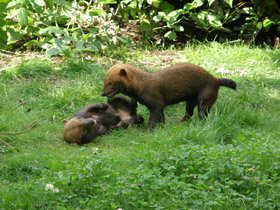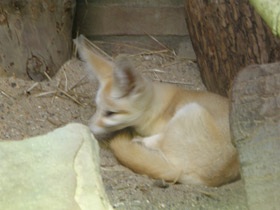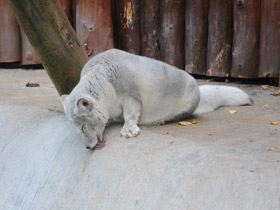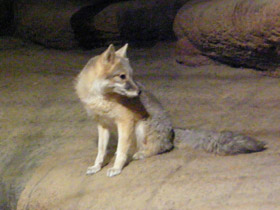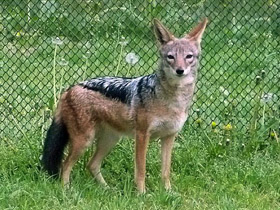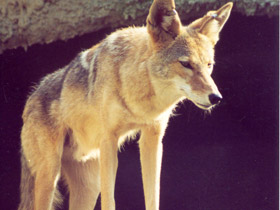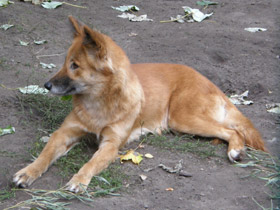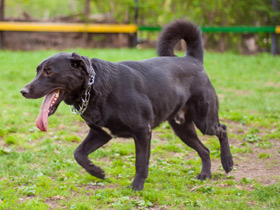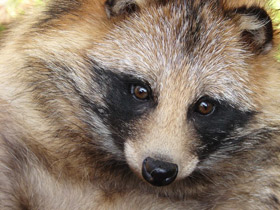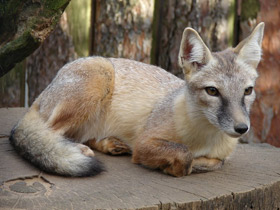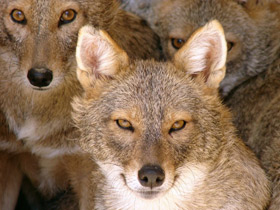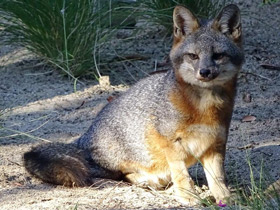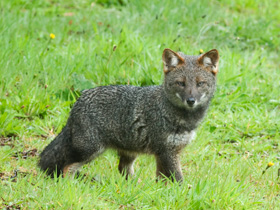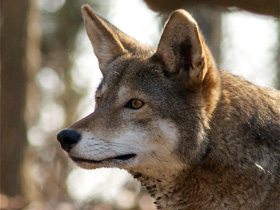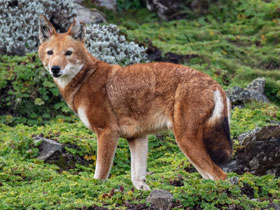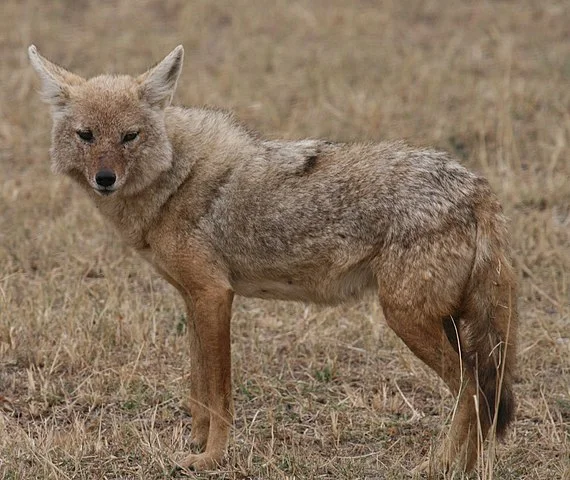The family Canidae
2. Корсак
3. Swift fox
4. Red fox
5. Fennec fox
6. Raccoon dog
7. Bat-eared fox
8. Manned wolf
9. Bush dog
10. Black-backed jackal
11. Golden jackal
12. Domestic dog
12-a. Dingo
13. Grey wolf
14. Coyote
15. Dhole
16. African wild dog
17. Island fox
Canidae (/ˈkænɪdiː/; from Latin, canis, "dog") is a biological family of dog-like carnivorans, colloquially referred to as dogs, and constitutes a clade. A member of this family is also called a canid (/ˈkeɪnɪd/). The family includes three subfamilies: the Caninae, the extinct Borophaginae and Hesperocyoninae. The Caninae are known as canines, and include domestic dogs, wolves, coyotes, foxes, jackals and other species.
Canids are found on all continents except Antarctica, having arrived independently or accompanied by human beings over extended periods of time. Canids vary in size from the 2-metre-long (6.6 ft) gray wolf to the 24-centimetre-long (9.4 in) fennec fox. The body forms of canids are similar, typically having long muzzles, upright ears, teeth adapted for cracking bones and slicing flesh, long legs, and bushy tails. They are mostly social animals, living together in family units or small groups and behaving co-operatively. Typically, only the dominant pair in a group breeds and a litter of young are reared annually in an underground den. Canids communicate by scent signals and vocalizations. One canid, the domestic dog, originated from a symbiotic relationship with Upper Paleolithic humans and today remains one of the most widely kept domestic animals.
Taxonomy
In the history of the carnivores, the family Canidae is represented by the two extinct subfamilies designated as Hesperocyoninae and Borophaginae, and the extant subfamily Caninae. This subfamily includes all living canids and their most recent fossil relatives. All living canids as a group form a dental monophyletic relationship with the extinct borophagines, with both groups having a bicuspid (two points) on the lower carnassial talonid, which gives this tooth an additional ability in mastication. This, together with the development of a distinct entoconid cusp and the broadening of the talonid of the first lower molar, and the corresponding enlargement of the talon of the upper first molar and reduction of its parastyle distinguish these late Cenozoic canids and are the essential differences that identify their clade.
The cat-like feliformia and dog-like Caniforms emerged within the Carnivoramorpha around 45–42 Mya (million years ago). The Canidae first appeared in North America during the Late Eocene (37.8-33.9 Mya). They did not reach Eurasia until the Miocene or to South America until the Late Pliocene.
Description
Canidae are a family of carnivorous mammals of the order Carnivora. Among others, it includes wolves (including dogs), jackals, coyotes, cuyotes, dingoes, wild dogs, aguarás guazú, guarás, pampas foxes or aguarachays, culpeo foxes and vulpinos (foxes). These animals are digitigrade. Their main characteristics, in general, include long, thin snouts and slender bodies.
Canids are carnivores with a light and slender build. The body is visibly compressed at the sides, elongated, flexible and strong. The head is elongated, with erect ears, and the tail is usually long and fluffy. The legs are strong but slender.
Canids are toe-walking animals, with four toes on the hind legs and five on the front legs.
All members of the family have blunt, non-tractile claws, which are useful for digging holes, but are not suitable for grasping prey.
Predatory teeth are well developed. The coat of most species is quite long and dense.
The canid family, one of the oldest of the carnivore order, includes small and medium-sized animals of 35 to 37 species.
Classification
For the current species, genetic studies agree on two tribes: Vulpini and Canini, but do not agree on the inclusion of specific species or genera. A distinction was first made between four main phylogenetic groups (Ostrander, 2008): the group including the common fox (genera Vulpes, Alopex, Nyctereutes and Otocyon), the group including the grey wolf (Canis, Cuon and Lycaon), the South American species (Atelocynus, Cerdocyon, Dusicyon, Lycalopex, Chrysocyon and Speothos) and, finally, the genus Urocyon, which is the most differentiated clade. The most recent studies include the clade of all the specifically South American genera, together with the clade of wolves within the tribe Canini and, on the other hand, within the tribe Vulpini, both the clade of the genus Vulpex (including Alopex and Fennecus) and the genus Urocyon, but leaving the genus Nyctereutes outside the two tribes.14 Other studies indicate however that Vulpes and Nyctereutes have a close phylogenetic relationship and form a sister group.
Canids are divided into three subfamilies, of which only one, the canine subfamily (Caninae), has living species:
- Subfamily Borophaginae †;
- Subfamily Hesperocyoninae †;
- Subfamily Caninae:
- Tribe Canini:
- Genus Canis:
- Canis anthus - African wolf.
- Canis aureus - common jackal, golden jackal or Moorish jackal.
- Canis latrans - coyote.
- Canis lupus - grey wolf.
- Canis lupus familiaris (Canis familiaris) - domestic dog (subspecies of the above).
- Canis lupus lupus - common wolf, European wolf or Eurasian wolf (from Europe and Asia).
- Canis lupus albus - tundra wolf (from northern Russia).
- Canis lupus arctos - Arctic wolf, polar wolf or white wolf (from the Canadian Arctic).
- Canis lupus baileyi - Mexican wolf (from Mexico and southeastern USA).
- Canis lupus campestris - steppe wolf or Caspian wolf (southern Kazakhstan, Iran, Afghanistan, Hungary and Romania).
- Canis lupus chanco - Tibetan wolf (eastern and central Asia and Tibet).
- Canis lupus dingo - dingo (species of ancient feral dog).
- Canis lupus crassodon - Vancouver wolf (from Vancouver Island).
- Canis lupus italicus - Italian wolf (subspecies now included in Canis lupus lupus lupus).
- Canis lupus arabs - Arabian wolf (from Egypt, Jordan, the Arabian Peninsula and Israel).
- Canis lupus occidentalis - Mackenzie wolf (from Alaska and northwestern Canada).
- Canis lupus pallipes (or Canis indica) - Indian wolf (from the Middle East and southwest Asia to India).
- Canis lupus signatus - Iberian wolf (subspecies now included in Canis lupus lupus lupus).
- Canis lupus hallstromi - New Guinea singing dog (from Papua New Guinea).
- Canis lupus irremotus - Rocky Mountain wolf (from the Rocky Mountains).
- Canis lupus manningi - Baffin wolf (from East Greenland).
- Canis lupus pambasileus - Yukon wolf or Alaskan black wolf (from Alaska, around Yukon).
- Canis rufus - red wolf.
- Canis rufus lycaon (or Canis lycaon) - Canadian red wolf.
- Canis himalayensis (or Canis lupus himalayensis) - Himalayan wolf.
- Canis simensis - Semitic jackal, Abyssinian wolf, Ethiopian wolf or caberu.
- Canis adustus - striped jackal.
- Canis mesomelas - black-backed jackal, black-backed jackal or black-backed jackal.
- Genus Cynotherium †:
- Cynotherium sardous †.
- Genus Atelocynus:
- Canis Atelocynus microtis - bush dog, small-eared fox or short-eared fox.
- Genus Cerdocyon:
- Canis Cerdocyon thous - crab fox, crab-dog fox, wolfhound, waterthog.
- Genus Chrysocyon:
- Canis Chrysocyon brachyurus - maned wolf, aguará guazú or borochi.
- Genus Dusicyon †:
- Canis Dusicyon australis † - Falkland wolf-fox.
- Canis Dusicyon avus †.
- Canis Dusicyon cultridens †.
- Genus Lycalopex:
- Lycalopex culpaeus - moor wolf, atoc, culpeo, or red fox or Fuegian fox.
- Lycalopex fulvipes - Chiloe fox or Darwin's fox.
- Lycalopex griseus - Chilla fox, grey fox or Patagonian fox.
- Lycalopex gymnocercus - Aguarachay, Azara fox or Pampas fox.
- Lycalopex sechurae - atoc, coastal wolf, Sechuran fox or Peruvian desert fox.
- Lycalopex vetulus - hoary fox or small-toothed fox.
- Genus Speothos:
- Canis Speothos venaticus - vinegar dog, vinegar fox, bush fox, vinegar dog, water dog, bush dog or jungle dog.
- Genus Lycaon:
- Lycaon pictus - African wild dog, African wild dog, painted wolf, hyena dog or Cape hunting dog.
- Lycaon sekowei † - southern wild dog.
- Genus Cuon:
- Cuon alpinus - cuon, dole, red dog, jaro dog, Asiatic wild dog or Indian wild dog.
- Tribe Vulpini:
- Genus Alopex:
- Alopex lagopus (or Vulpes lagopus) - polar fox, arctic fox, white fox or snow fox.
- Genus Otocyon:
- Otocyon megalotis - otocyon or eared fox.
- Genus Urocyon:
- Urocyon cinereoargenteus - grey tree fox.
- Urocyon littoralis - Island fox.
- Genus Vulpes:
- Vulpes bengalensis - Bengal fox.
- Vulpes cana - Blanford fox, Afghan fox or steppe fox.
- Vulpes chama - Cape fox.
- Vulpes corsac - Mongolian fox.
- Vulpes ferrilata - Tibetan fox or sand fox.
- Vulpes macrotis - Kit fox.
- Vulpes pallida - Pallid fox.
- Vulpes rueppellii - Rüppell's fox or sand fox.
- Vulpes velox - swift fox or kite fox.
- Vulpes vulpes - red fox or common fox.
- Vulpes zerda (or Fennecus zerda) - phoenec or desert fox.
- Incertae sedis
- Genus Nyctereutes
- Nyctereutes procyonoides - raccoon dog or tanuki.

















